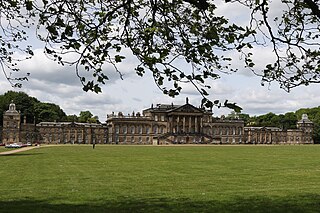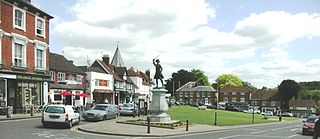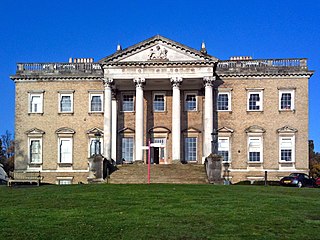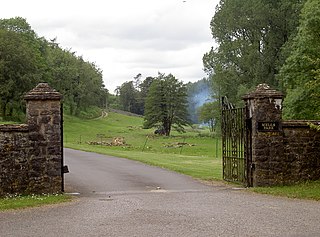
Keston is a village in Greater London, England, located within the London Borough of Bromley, Greater London. Prior to 1965 it was within the historic county of Kent. It is part suburban, part rural in nature and lies on the edge of Hayes Common, just beyond the London conurbation to the south of Bromley Common. It includes the small hamlet of Nash to the southwest. The northern, more suburban part of Keston is sometimes referred to as Keston Mark.

Castle Howard is a stately home in North Yorkshire, England, within the civil parish of Henderskelfe, located 15 miles (24 km) north of York. It is a private residence and has been the home of the Carlisle branch of the Howard family for more than 300 years. Castle Howard is not a fortified structure, but the term "castle" is sometimes used in the name of an English country house that was built on the site of a former castle.

Wentworth Woodhouse is a Grade I listed country house in the village of Wentworth, in the Metropolitan Borough of Rotherham in South Yorkshire, England. It is currently owned by the Wentworth Woodhouse Preservation Trust. The building has more than 300 rooms, with 250,000 square feet (23,000 m2) of floorspace, including 124,600 square feet (11,580 m2) of living area. It covers an area of more than 2.5 acres (1.0 ha), and is surrounded by a 180-acre (73 ha) park, and an estate of 15,000 acres (6,100 ha).

Wilton House is an English country house at Wilton near Salisbury in Wiltshire, which has been the country seat of the Earls of Pembroke for over 400 years. It was built on the site of the medieval Wilton Abbey. Following the dissolution of the monasteries, Henry VIII presented Wilton Abbey and its attached estates to William Herbert, 1st Earl of Pembroke. The house is linked by some with the premiere of Shakespeare's As You Like It, and an important litterary saloon culture under its occupation by Mary Sidney, wife of the first Earl.

Knole is a country house and former archbishop's palace owned by the National Trust. It is situated within Knole Park, a 1,000-acre (400-hectare) park located immediately to the south-east of Sevenoaks in west Kent. The house ranks in the top five of England's largest houses, under any measure used, occupying a total of four acres.

Westerham is a town and civil parish in the Sevenoaks District of Kent, England. It is located 3.4 miles east of Oxted and 6 miles west of Sevenoaks, adjacent to the Kent border with both Greater London and Surrey. It is recorded as early as the 9th century, and was mentioned in the Domesday Book in a Norman form, Oistreham. Hām is Old English for a village or homestead, and so Westerham means a westerly homestead. The River Darent flows through the town, and formerly powered three watermills.

Claremont, also known historically as 'Clermont', is an 18th-century Palladian mansion less than a mile south of the centre of Esher in Surrey, England. The buildings are now occupied by Claremont Fan Court School, and its landscaped gardens are owned and managed by the National Trust. Claremont House is a Grade I listed building.

Witley Court, in Great Witley, Worcestershire, England, is a ruined Italianate mansion. Built for the Foleys in the seventeenth century on the site of a former manor house, it was enormously expanded in the early nineteenth century by the architect John Nash for Thomas Foley, 3rd Baron Foley. The estate was later sold to the Earls of Dudley, who undertook a second massive reconstruction in the mid-19th century, employing the architect Samuel Daukes to create one of the great palaces of Victorian and Edwardian England.

Eastwell Park is a large area of parkland and a country estate in the civil parish of Eastwell, adjoining Ashford, Kent, in England. It was owned by the Earls of Winchilsea for more than three centuries. Over time, successive buildings have served as homes to Sir Thomas Moyle, the Earls of Winchilsea and Nottingham, Prince Alfred, Duke of Edinburgh, and others.

Siston is a small village in South Gloucestershire, England. It is 7 miles (11 km) east of Bristol at the confluence of the two sources of the Siston Brook, a tributary of the River Avon. The village consists of a number of cottages and farms centred on St Anne's Church, and the grand Tudor manor house of Siston Court. Anciently it was bordered to the west by the royal Hunting Forest of Kingswood, stretching westward most of the way to Bristol Castle, always a royal possession, caput of the Forest. The local part of the disafforested Kingswood became Siston Common but has recently been eroded by the construction of the Avon Ring Road and housing developments. In 1989 the village and environs were classed as a conservation area and thus have statutory protection from overdevelopment.

General George Warde was a British Army officer. The second son of Colonel John Warde of Squerryes Court in Westerham, and Miss Frances Bristow of Micheldever. He was a close childhood friend of James Wolfe, the Conqueror of Quebec. He became a colonel in the Royal Horse Guards.. In 1773 he became colonel of the 14th Dragoons, then in 1791 was appointed Commander-in-Chief, Ireland, a post which earned him the rank of general in 1796.

Cobham Hall is an English country house in the county of Kent, England. The grade I listed building is one of the largest and most important houses in Kent, re-built as an Elizabethan prodigy house by William Brooke, 10th Baron Cobham (1527–1597). The central block was rebuilt 1672–82 by Charles Stewart, 3rd Duke of Richmond, 6th Duke of Lennox (1639–1672).

Holkham Hall is an 18th-century country house near the village of Holkham, Norfolk, England, constructed in the Neo-Palladian style for the 1st Earl of Leicester by the architect William Kent, aided by Lord Burlington.
Series 1 of the ITV programme Foyle's War was first broadcast in 2002; comprising four episodes, it is set in Spring/Summer 1940.
Sir Edward Leech was an English lawyer and politician who sat in the House of Commons between 1614 and 1625.

Killruddery House is a large country house on the southern outskirts of Bray in County Wicklow, Ireland, approximately 20 km (12 mi) south of Dublin. The present structure is a south facing multi-bay mansion, originally dating from the 17th century, but remodelled and extended in 1820 in the Elizabethan style. It is constructed as variously single, two, three and four storeys in the shape of an irregular quadrangle enclosing a courtyard. To the north an office wing incorporates the 17th-century portion and to the south and west is a large domed conservatory, the orangery, designed by William Burn in about the 1850s. The house sits within a large landscaped demesne which features a pair of 550-foot long parallel reflecting pools on the south lawn.

Mells Park is a country estate of 140 hectares near Mells, Somerset, England. It originated as a 17th-century deer park, probably created by the Horner family, who had been the owners of Mells Manor from 1543. The Horners expanded the park and planted extensive woodlands, resulting in a large collection of mature trees, especially 18th-century plantings of oak, lime and beech. The park is Grade II listed in the National Register of Historic Parks and Gardens. It contains Park House, also known as Mells Park House, a Grade II* listed building, built in 1925 in neoclassical style by the architect Edwin Lutyens, replacing an 18th-century house of the same name. It is c. 1 mile (1.6 km) west of Mells Manor House, which does not lie within the park.
Squerryes Estate is a vineyard, estate, and location of Squerryes Court, a grade I listed building in Kent, England. It is a producer of English sparkling wine.
William Cromer was an English Sheriff and Lord Mayor of London and a Member of Parliament for the city.

Holy Trinity Church is a Church of England parish church based in Crockham Hill, Kent, England. It was constructed in 1842 and is a Grade II listed building.



















